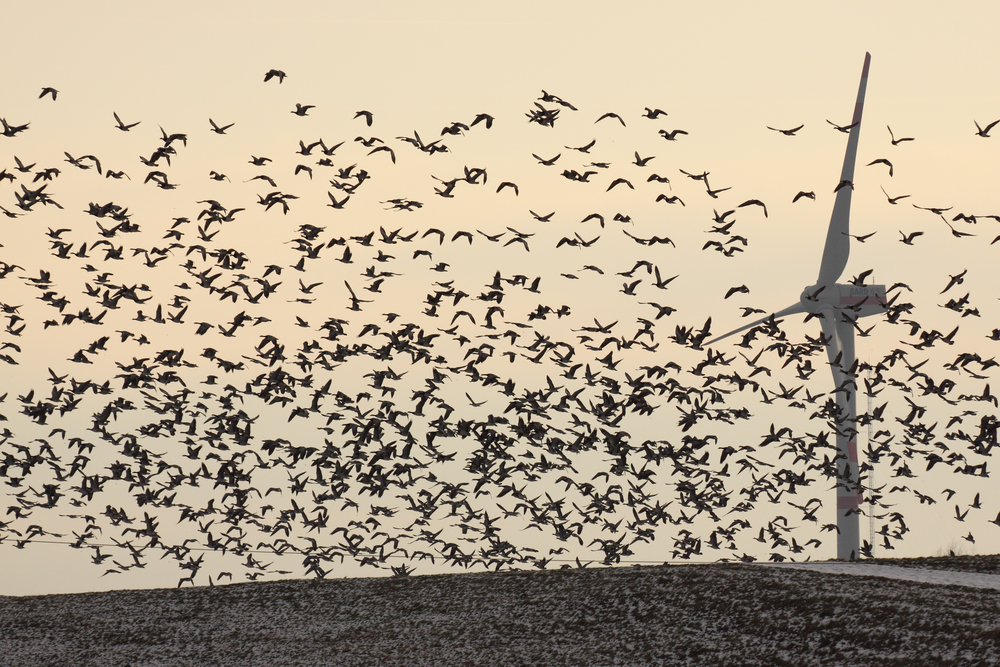People who oppose wind farms often claim wind turbine blades kill large numbers of birds, often referring to them as “bird choppers”. And claims of dangers to iconic or rare birds, especially raptors, have attracted a lot of attention.
Wind turbine blades do indeed kill birds and bats, but their contribution to total bird deaths is extremely low, as these three studies show.
A 2009 study using US and European data on bird deaths estimated the number of birds killed per unit of power generated by wind, fossil fuel and nuclear power systems.
It concluded:
wind farms and nuclear power stations are responsible each for between 0.3 and 0.4 fatalities per gigawatt-hour (GWh) of electricity while fossil-fuelled power stations are responsible for about 5.2 fatalities per GWh.
That’s nearly 15 times more. From this, the author estimated:
wind farms killed approximately seven thousand birds in the United States in 2006 but nuclear plants killed about 327,000 and fossil-fuelled power plants 14.5 million.
In other words, for every one bird killed by a wind turbine, nuclear and fossil fuel powered plants killed 2,118 birds.
A Spanish study involved daily inspections of the ground around 20 wind farms with 252 turbines from 2005 to 2008. It found 596 dead birds.
The turbines in the sample had been working for different times during the study period (between 11 and 34 months), with the average annual number of fatalities per turbine being just 1.33. The authors noted this was one of the highest collision rates reported in the world research literature.
Raptor collisions accounted for 36% of total bird deaths (214 deaths), most of which were griffon vultures (138 birds, 23% of total mortality). The study area was in the southernmost area of Spain near Gibraltar, which is a migratory zone for birds from Morocco into Spain.
Perhaps the most comprehensive report was published in the journal Avian Conservation and Ecology in 2013 by scientists from Canada’s Environment Canada, Wildlife Research Division.
Their report looked at causes of human-related bird deaths for all of Canada, drawing together data from many diverse sources.
The table below shows selected causes of bird death out of an annual total of 186,429,553 estimated deaths caused by human activity.
Mark Duchamp, the president of Save the Eagles International is probably the most prominent person to speak out about bird deaths at wind farms. He says:
The average per turbine comes down to 333 to 1,000 deaths annually which is a far cry from the 2-4 birds claimed by the American wind industry or the 400,000 birds a year estimated by the American Bird Conservancy for the whole of the United States, which has about twice as many turbines as Spain.
Such claims from wind farm critics generally allude to massive national conspiracies to cover up the true size of the deaths.
And in Australia?
In Australia in 2006 a proposal for a 52-turbine wind farm plan on Victoria’s south-east coast at Bald Hills (now completed) was overruled by the then federal environment minister Ian Campbell.
He cited concerns about the future of the endangered orange-bellied parrot (Neophema chrysogaster), a migratory bird said to be at risk of extinction within 50 years. The Tarwin Valley Coastal Guardians, an anti wind farm group, had been opposing the proposed development.
Interest groups have regularly cited this endangered bird when trying to halt a range of developments.
These include a chemical storage facility and a boating marina. The proposed Westernport marina in Victoria happened to also be near an important wetland. But a professor in biodiversity and sustainability wrote:
the parrot copped the blame, even though it had not been seen there for 25 years.
Victoria’s planning minister at the time, Rob Hulls, described the Bald Hills decision as blatantly political, arguing the federal conservative government had been lobbied by fossil fuel interests to curtail renewable energy developments. Hulls said there had been:
some historical sightings, and also some potential foraging sites between 10 and 35 kilometres from the Bald Hills wind farm site that may or may not have been used by the orange-bellied parrot.
Perhaps the final word on this topic should go to the British Royal Society for the Protection of Birds. It built a wind turbine at its Bedfordshire headquarters to reduce its carbon emissions (and in doing so, aims to minimise species loss due to climate change). It recognised that wind power is far more beneficial to birds than it is harmful.
Simon Chapman is Emeritus Professor in Public Health at the University of Sydney. Simon Chapman and Fiona Crichton’s book, Wind Turbine Syndrome: a communicated disease, was published by Sydney University Press in November 2017.
This article was originally published on The Conversation. Read the original article.
Subscribe to our newsletter
Stay up to date with DeSmog news and alerts







